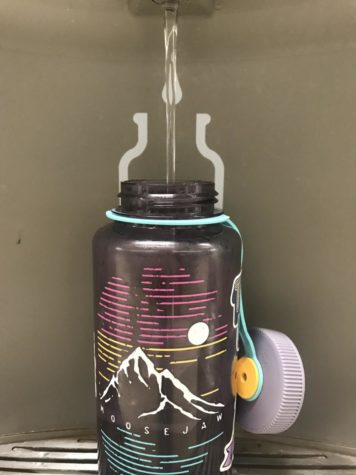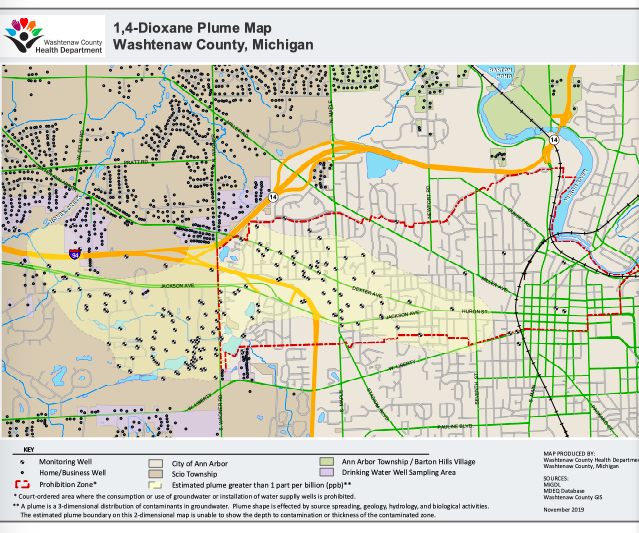The Gelman Plume represents an ongoing environmental crisis in Michigan, more specifically Ann Arbor. This Plume is essentially the spread of 1-4 Dioxane, a highly toxic and possibly cancer causing chemical used to make medical filters.
According to Jason Bing, director of Capital Projects for Ann Arbor Public Schools, “Skyline’s drinking water is City of A2 supplied water (no onsite well water). So this would be water supplied from the City of A2’s water treatment plant, which pulls water from the Huron River and groundwater from local wells, treats and processes it, and distributes it to the A2 community through its water infrastructure (pipes underground).” There is no threat to Ann Arbor water supply at this time. Brian Steglitz, Ann Arbor Water Treatment Services Unit Manager stated that the well water used in the AAPS water supply is “located on the Ann Arbor airport property. We have one well that was contaminated with 1,4 dioxane located on the west side of Ann Arbor near Slauson school that we have not used for about 20 years due to the contamination.” He also noted that “The recent detection near Skyline on Blueberry Lane has been resampled and the results were non-detect. The State of Michigan is working to continue to sample at that location to determine if the results were an anomaly or if the dioxane has really reached that location at that concentration.” If the Dioxane reached that location it would be out of the Prohibition Zones.
The Prohibition Zones are areas in Ann Arbor where you are legally not allowed to drink the water because of the toxic amount of dioxane in the water. These Zones were established back when dioxane was originally detected in the 1960’s they include the “areas south of M-14, north of West Liberty Street, east of Wagner Road, and west of the Huron River.” They have the possibility of expanding if improper state monitoring continues. The areas outlined in red on this map are areas where it is toxic to drink water in Ann Arbor. While these areas are not actively spreading, it is important to stay informed.
In a recent public meeting of both a local environmental group in Washtenaw County called “Card WC” as well as Michigan’s environmental council (EGLE), improper methods used to test the Plume’s whereabouts were discussed due to the reveal of dioxane in a residential well North of Skyline High School.
Gelman Sciences on Wagner Road created medical filters from the 1960-1980’s until local news sources in 1992 reported Gelman had released 1-4 dioxane chemicals into Ann Arbor soil. The Plume has been a consistent issue ever since, with numerous consent judgements filed and trials held to date, the most recent in June 2021.

In the fourth consent judgment filed, which is a mutual agreement between Gelman and the City of Ann Arbor, Gelman agreed to “investigate, clean up, contain and monitor the contaminated groundwater, underthe direction of EGLE,” according to Ann Arbor environment officials. The monitoring for the Gelman site fell into the hands of the Michigan Government and Gelman Sciences.
Despite several legal filings and cleaning procedures being underway, the public remains concerned. “The state and the polluter are not doing enough testing to the north, so Scio Township took it upon themselves to do drinking water well testing,” said an Ann Arbor community member present at the quarterly online meeting. While the federally regulated timeline of Dioxane testing is unclear, Ann Arbor residents present at the public meeting felt further testing was necessary to feel safe drinking their water.
“We need to come up with a resolution between the state, county, whomever that 522 the EPA recommended method for testing for dioxane be used in future tests,” say local Environmental officials at the meeting. This form of testing would help speed up testing times and help communicate information to the public in a timely fashion, it is also a more effective method than what is being used currently.
Efficient testing has been an issue in the past. According to EGLE officials, there were “some significant delays because everybody seemed to want to use the labs at the end of the year and when [they] got them back there was the big problem of rescheduling.” This delayed the possible response to the Plume spreading. EGLE as well as Gelman Manufacturing are responsible for the clean up procedures.
A2 gov update page with brief Q and A’s and court links: https://www.a2gov.org/departments/water-treatment/Pages/Gelman-1,4-Dioxane-Litigation.aspx
State department of Health and Human services for risks to health and overall updates as of Nov 19th, 2022: https://www.washtenaw.org/DocumentCenter/View/5121/Washtenaw-County-Health-Department-Fact-Sheet-on-14-Dioxane-PDF?bidId=








